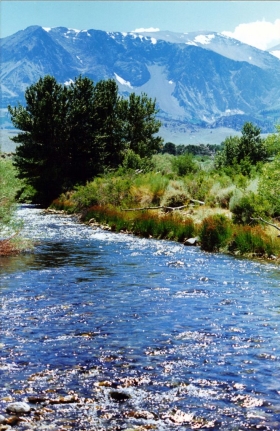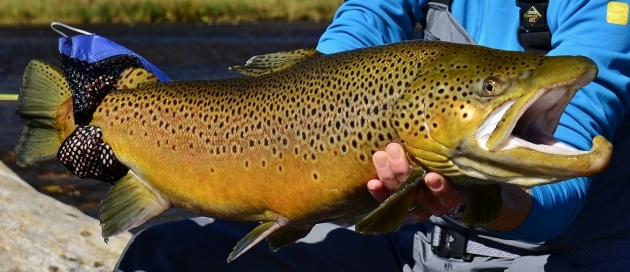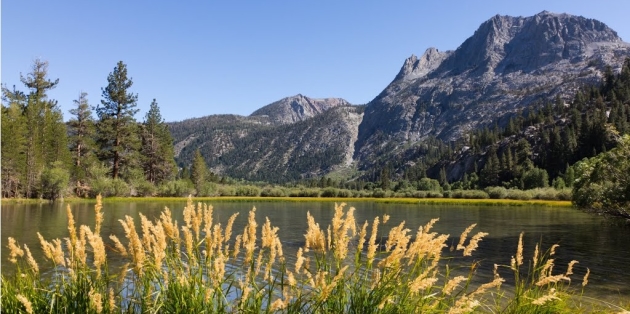Everything You Ever Wanted to Know About Brown Trout and other trout species along June Lake Loop and the Rush Creek Watersheds. A Technical Whitepaper. July 17, 2014.
Ross N. Taylor has provided this important whitepaper on the Brown Trout populations along June Lake Loop, Rush Creek and Mono Lake. Most anglers will appreciate the tremendous quality of information that will help them enjoy fishing for Brown Trout and contributing with active involvement to the long-term survival of this incredible trout species. Reproduction of this whitepaper without permission of June Lake Accommodations is strictly prohibited. We also want to invite all trout anglers to stay with us in one of our cozy and affordable vacation rentals here in June Lake.

By Ross N. Taylor, Lead Fisheries Scientist, State Water Resources Control Board, Mono Basin Monitoring Program. Mr. Taylor is also a Fisheries Consultant with Ross Taylor and Associates.
Prior to, and immediately after, the completion of Grant Lake Dam by LADWP; records suggest that two distinct fisheries existed on Rush Creek. In the lower watershed, the fishery was focused on the reach of Rush Creek downstream of the Narrows, a natural bedrock constriction. The lower reach was referred to as the “Bottomlands” and was a low-gradient, meandering channel with many characteristics of a spring creek system. Throughout most of the 1930s and 1940s, this fishery was physically separated from upper Rush Creek because in-basin irrigation diversions at Grant Lake often dewatered Rush Creek between Grant Lake and the Narrows. The spring creek conditions in the Bottomlands were formed by a combination of natural spring flow and the return of water being irrigated onto the Cain Ranch and Pumice Valley. The nutrient-rich irrigation return combined with natural spring flow created ideal habitat for brown trout to grow quickly to large sizes. In addition, several ponds adjacent to Rush Creek were dug and filled with stream flow for duck hunting near Mono Lake and apparently large brown trout were caught in these ponds during the 1930s and 1940s. Once LADWP started diverting water out of the Mono Basin in 1941, the lower Rush Creek fishery diminished and then disappeared as LADWP eventually diverted virtually all the flow, except in the wettest of years. The gradual disappearance of the springs and trout fishery was well documented by Eldon Vestal and published in a 1954 Fish and Game report.

The trout fishery in the Rush Creek watershed above Grant Lake was focused in both the series of lakes (Grant, Silver, Gull and June) and in the creek itself. Historically, this fishery was a mixed species fishery for whatever species was being stocked at the time and also for trout that were residing in the lakes and naturally spawning in the creek. Vestal’s records indicate that Ventura River steelheads were stocked in June Lake during the 1920s and these stockings may have also unintentionally introduced three-spine stickleback to the watershed. Vestal’s records from the trapping station on Rush Creek above Grant Lake revealed that brown trout were growing to large sizes in the lake and moving up into Rush Creek for spawning in the fall. One of the exhibits in his State Water Board deposition was a photograph of an 18-inch long female brown trout captured on October 10, 1939 at the fish trap. Additional trapping records provided by Vestal reported a size range of 14 to 27 inches for captured brown trout.

Rush Creek above Grant Lake Reservoir (and the lakes) are currently managed as primarily put-and-take fisheries for stocked rainbow trout. Brook trout are occasionally caught, but are not considered a common species. All brown trout in upper Rush Creek and the lakes are naturally reproducing fish – the stocking of brown trout ceased at least 40 years ago. Although the naturally reproducing brown trout population in Rush Creek below Grant Lake Reservoir has been the focus of intense studies because of LADWP’s settlement agreement to restore Mono Lake, the self-sustaining brown trout fishery in the upper watershed has been virtually ignored. The life history pattern most likely exhibited by these fish includes younger brown trout residing in Rush Creek and larger fish spending most of the year in a lake environment with seasonal movements into Rush Creek for late-fall/early-winter spawning. A three-year long radio tagging study of brown trout in lower Rush Creek determined that most movement and spawning occurred in October through December.
Brown trout typically spawn in the tail-out of pools or within riffles where appropriate sized substrate is available (pea to golf ball sized gravel). The female fish digs a nest (called a redd) and one or more males fertilize the eggs. Both female and male brown trout can survive to spawn multiple times and as females grow larger they typically produce more eggs. The incubation of the eggs is a function of water temperature, with cooler temperatures resulting in longer incubation periods. Once hatched, the juvenile fish remain within the streambed absorbing their yolk sacs prior to emergence. Based on lower Rush Creek water temperature data, the estimated time from fertilization to emergence ranged from 162 to 196 days. Thus, eggs laid in the fall result in fry emerging in May and June.
For most of the year large brown trout are typically an elusive fish and relatively difficult to catch. This is due to them living in the larger lakes, often feeding at night and selective feeding on forage fish or larger prey items. Their susceptibility to being caught increases dramatically when they enter small creeks to spawn, such as Rush Creek upstream of Grant Lake Reservoir. These large fish are in relatively shallow water, often visible to anglers, and are in an aggressive mood because they are spawning. In a more natural lake/river environment, spawning brown trout may have access to many miles of potential spawning habitat. However, brown trout leaving Grant Lake Reservoir for spawning purposes are confined to less than three miles of creek, thus increasing their vulnerability to capture and harvest by anglers. Because the fishery for larger, lake-dwelling brown trout on all the lakes along upper Rush Creek is dependent on the steady recruitment of naturally spawned fish, modifying angling regulations to protect creek-spawning fish in the fall months should be considered. Reducing mortality, but still allowing angling opportunities could be accomplished by implementing catch-and-release, no bait, single barbless hooked lures or flies only regulations during October and November.

Improved management decisions could also be made if studies were implemented to better understand the population dynamics of upper Rush Creek’s brown trout fishery. For example, what is the run size of spawners out of Grant Lake Reservoir? How old are these fish? When and where do they spawn? Post-spawn, do they return quickly to the lake or reside in the creek for the winter? Are female brown trout successfully spawning multiple times? At what age and size do juvenile fish leave Rush Creek and enter the lakes? Do fish move between Grant Lake Reservoir and Silver Lake? What do the fish eat in the lakes? Is this forage base limited in any way? If so, what are the limitations and can these be controlled by fisheries management practices? Answers to some of these questions can assist fisheries managers in balancing the often competing goals of a maintaining a robust population of naturally reproducing, lake-dwelling brown trout and providing ample opportunities for all anglers.
We’ll send you updates on vacation rentals as well as what’s happening in the June Lake area.
Get exclusive info for our rentals in June Lake.
© 2025 | June Lake Accommodations All rights reserved.
Terms of Use | Privacy Policy | Sitemap | Owner Login | Guest Portal